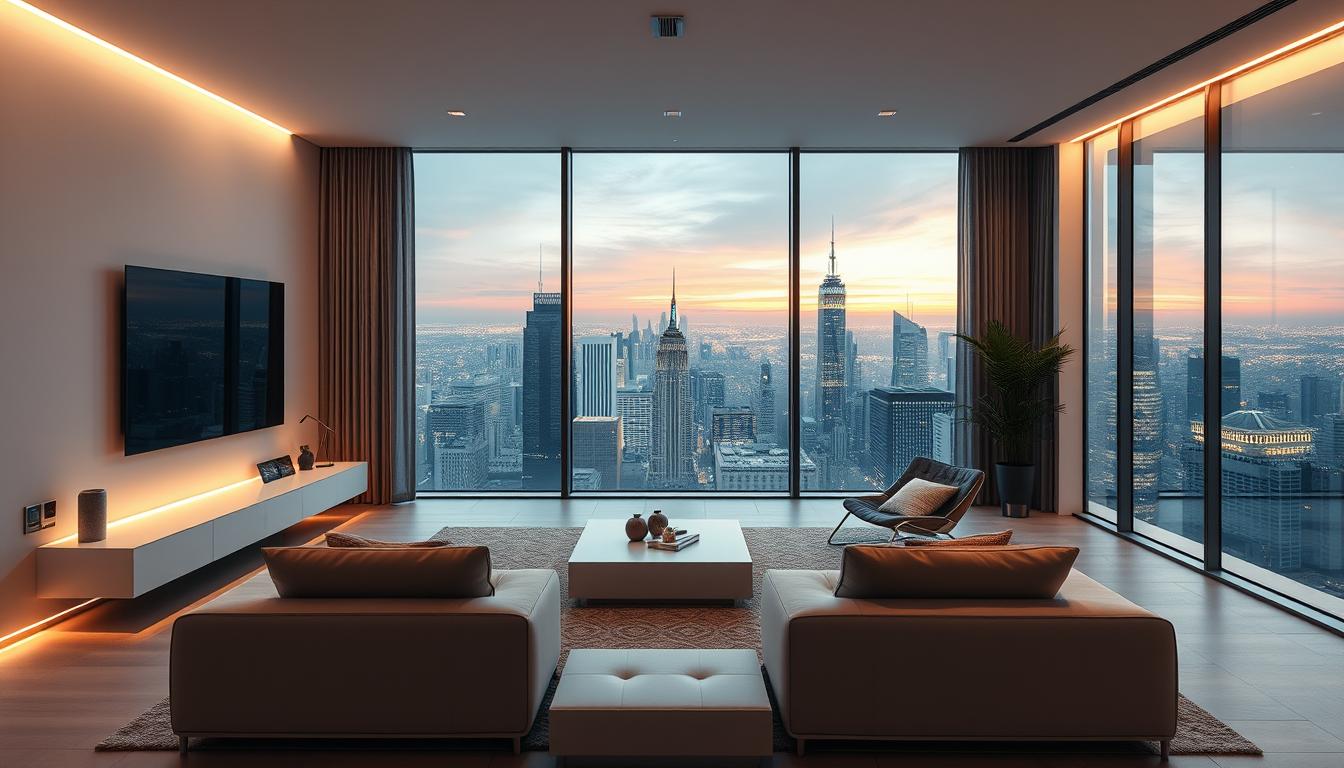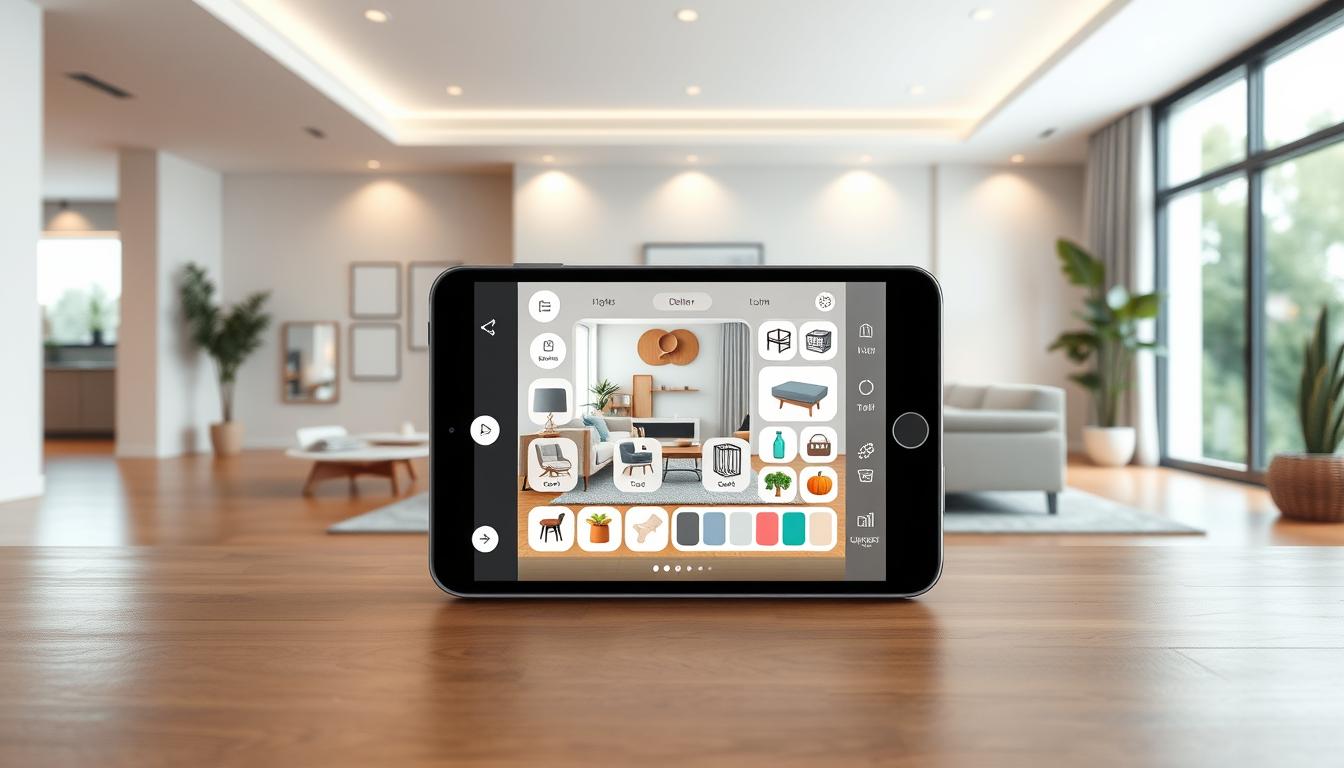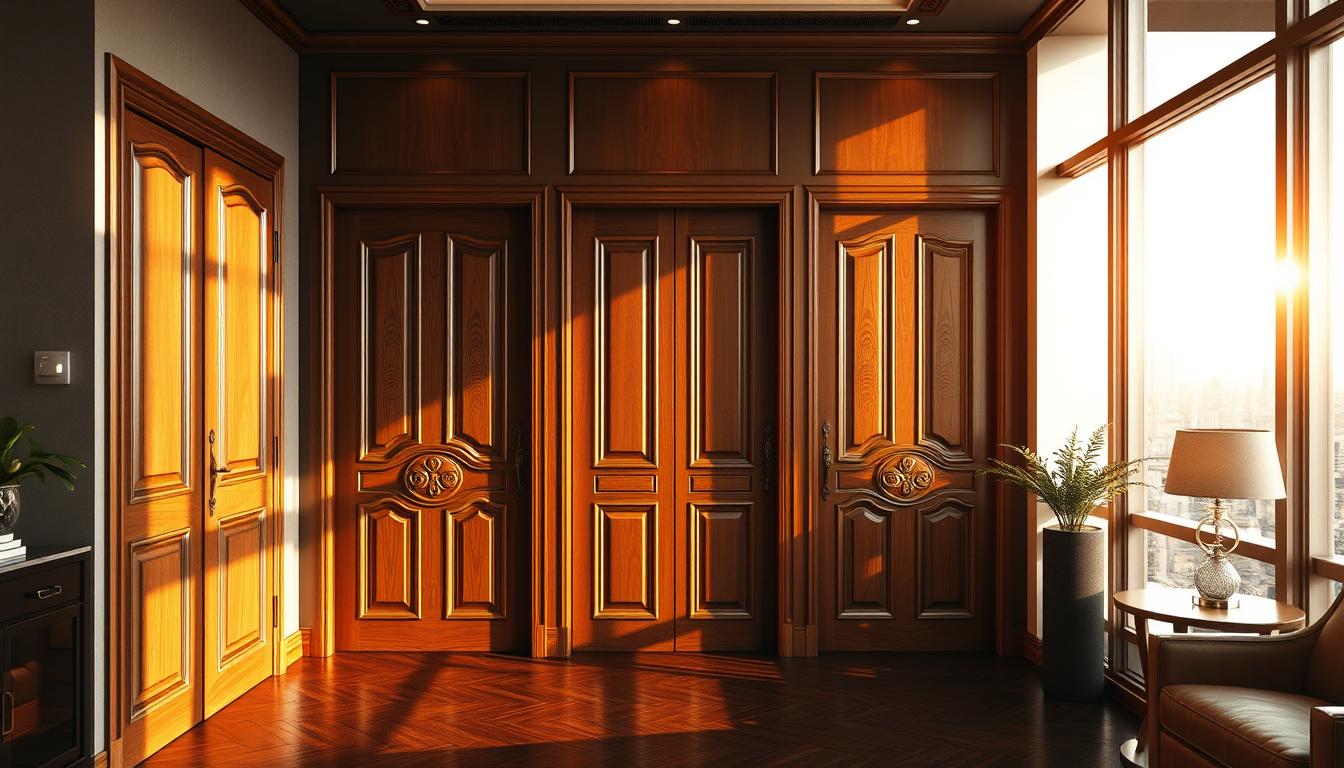The world is getting more connected, and our homes are no exception. By 2028, there will be over 785 million smart homes worldwide. This is changing how we see interior design.
This trend is about making our living spaces more convenient and fun. As technology becomes part of our lives, our homes are turning into centers of innovation and comfort.
Key Takeaways
- Smart home technology is transforming interior design.
- The number of smart homes is expected to reach 785 million by 2028.
- Creating a tech-savvy living space enhances convenience and efficiency.
- Smart homes are becoming hubs of innovation and comfort.
- Interior design is evolving to incorporate technology seamlessly.
What is Smart Home Interior Design?
Smart home interior design blends new technology with style to make homes more useful. It uses smart tech to make living easier and more enjoyable.
At its heart, it’s about making homes both beautiful and smart. It places smart devices in smart ways to boost home function and ease.
Definition and Overview
Smart home technology connects devices to a central hub, often online. It aims to make homes work better and be more convenient. Smart home design goes further by fitting these techs into the home’s design.
This means adding smart lighting solutions and voice-controlled assistants. These features aim to simplify life and add joy to the homeowner’s experience.
Key Components of Smart Home Design
Smart home design has several main parts. Here’s a quick rundown:
| Component | Description | Benefits |
|---|---|---|
| Smart Lighting | Systems that adjust lighting based on the time of day or occupancy | Energy efficiency, enhanced ambiance |
| Smart Thermostats | Devices that learn and adjust the temperature for optimal comfort and energy savings | Improved comfort, reduced energy bills |
| Voice-Controlled Assistants | Devices that allow for voice control of various smart home features | Increased convenience, hands-free control |
These parts work together to make a smart home that’s both useful and stylish. Knowing about these elements helps homeowners choose the right tech for their homes.
Benefits of Smart Home Interior Design
Smart home interior design offers many benefits. It makes our homes more convenient, secure, and energy-efficient. By using smart technologies, we can make our living spaces better in many ways.
Improved Convenience
One big plus of smart home design is how convenient it is. For example, smart lighting lets you change the mood of your home with just a few taps on your phone. Voice assistants like Amazon Alexa or Google Home make it even easier, letting you control your home without touching each device.
Smart home automation makes our daily lives simpler. You can set your thermostat to adjust the temperature for you. This way, your home is always comfortable when you need it to be.
Enhanced Security
Smart home tech also boosts home security. Devices like Ring security cameras keep an eye on your home and alert you to any movement. This helps keep intruders away and gives you peace of mind.
Smart locks are another key part of better security. They let you control who can enter your home, all from your phone. This is great for managing guest access or service providers.
Energy Efficiency
Smart home design also saves energy. Smart thermostats learn your preferences and adjust the temperature for you. Smart lighting turns off when not needed, cutting down on energy waste.
| Benefit | Description | Example Technology |
|---|---|---|
| Improved Convenience | Simplifies home management and daily routines | Voice-controlled assistants |
| Enhanced Security | Provides surveillance and access control | Ring security cameras, Smart locks |
| Energy Efficiency | Optimizes energy consumption | Smart thermostats, Smart lighting |
By using these technologies, we can make our homes more comfortable, secure, and green. The future of smart home design looks bright and full of possibilities.
Popular Smart Home Technologies
Popular smart home technologies are changing how we live. They turn our homes into smart, responsive places that meet our needs. These technologies are making our homes more than just places to live.
Smart home technologies like smart lighting, smart thermostats, and voice-controlled assistants are key. They make our homes more connected and efficient. Let’s explore how they work and their benefits.
Smart Lighting Solutions
Smart lighting does more than just light up our homes. It changes the feel and function of our spaces. We can control lights from anywhere, change colors, and set scenes for different times or activities.
- Energy Efficiency: Smart lighting cuts down on energy use by using light wisely.
- Customization: We can make lighting fit our mood and needs, creating the right atmosphere.
- Integration: Smart lighting works with other smart devices, making our homes smarter.
Smart Thermostats
Smart thermostats make our homes comfortable and energy-efficient. They learn our temperature likes and adjust the heat or cool as needed. This keeps our homes just right.
- Energy Savings: Smart thermostats save energy by adjusting heating and cooling.
- Comfort: They keep our homes cozy, adjusting to our schedules and likes.
- Remote Control: We can change the temperature from anywhere, making our home welcoming when we get home.
Voice-Controlled Assistants
Voice-controlled assistants like Amazon Alexa and Google Assistant are key to smart homes. They let us control devices with voice commands. This makes managing our smart homes easy.
- Convenience: Voice control simplifies managing many smart devices at once.
- Integration: These assistants work with many devices, improving our smart home setup.
- Accessibility: Voice control makes smart home use easy for everyone, including those with mobility issues.
By using these smart home technologies, we can make our homes more efficient and fun. As tech advances, we’ll see even more cool solutions for smart homes.
Designing a Smart Home: The Basics
To design a smart home, start by looking at your living space. Think about how technology can make your life better. Know your home’s layout, what you like, and your budget.
Assessing Your Space
Start by walking through your home. Find spots for smart devices. Look at lighting, temperature, and entertainment systems.
- Identify rooms that need smart lighting solutions.
- Determine if your thermostat can be upgraded to a smart thermostat.
- Consider voice-controlled assistants for easier control over your devices.
This helps you see how smart tech can fit into your life. It makes your home more efficient and fun.
Identifying Your Needs
Knowing what you need is key. Think about what you want from your smart home. Do you want better security, to save energy, or just make life easier?
| Need | Smart Home Solution |
|---|---|
| Enhanced Security | Smart door locks, security cameras |
| Energy Efficiency | Smart thermostats, energy monitors |
| Convenience | Voice-controlled assistants, smart lighting |
As innovative interior design ideas come up, making your home tech-friendly gets easier. The goal is to mix function and beauty well.
“The future of home design is not just about looking good, it’s about feeling good and living well through technology.”
By knowing what you need and looking at your space, you can make a smart home. It will be useful and look great, improving your life.
How to Choose Smart Home Devices
Choosing the right smart home devices is key to a great smart home. It’s important to pick devices that work well together and meet your needs. Think about what you need and how devices will work together for a smooth experience.
Compatibility Considerations
When picking smart home devices, compatibility is key. Devices that don’t work together can make your home feel disjointed. Choose devices that use the same system, like Google Home or Apple HomeKit, for easy control.
Make sure your devices work with your voice assistant, like a smart speaker. This lets you control everything with just your voice. For more info, check out PCMag for top smart home picks.
Budget-Friendly Options
Smart home devices vary in price. Setting a budget helps you choose. Start with must-have devices like smart thermostats or lights.
There are many budget-friendly options that still offer great benefits. Smart light bulbs, for example, can be controlled from anywhere. Remember to factor in the cost of any hubs or bridges needed for your devices.
Essential vs. Optional Devices
It’s important to know the difference between essential and optional devices. Essential devices, like security cameras or smart locks, are crucial for safety and convenience.
Optional devices, like smart coffee makers, add extra features but aren’t necessary. Focus on essential devices first, then add optional ones based on your budget and needs.
Integrating Technology Seamlessly
The secret to a futuristic home is mixing tech with design smoothly. As we dive into smart home tech, we need to think about how to blend it with our decor. This ensures our homes look great without losing their tech edge.
To make this work, we focus on two main things: hiding wires and picking simple designs. These steps help us achieve a clean, clutter-free look. This look showcases our innovative interior design ideas beautifully.
Hiding Wires and Cables
Managing the wires from smart devices is a big challenge in tech homes. We can use cable management systems or design homes with secret spots for wires. These methods help keep our homes tidy and safe.
| Method | Description | Benefits |
|---|---|---|
| Cable Management Systems | Using cable ties, cord organizers, or cable trays to keep wires tidy. | Reduces clutter, improves safety. |
| Hidden Compartments | Designing homes with hidden spaces for wires and cables. | Enhances aesthetic appeal, reduces visible clutter. |
Choosing Minimalist Designs
Designing our smart devices is key to a tech-savvy home. Choosing simple designs that are both functional and easy to use is important. This makes our smart homes look good and work well.
By picking devices with clean lines and simple interfaces, we make our homes futuristic and functional. This approach shows off our futuristic interior design concepts. It also keeps our smart homes easy to use and nice to look at.
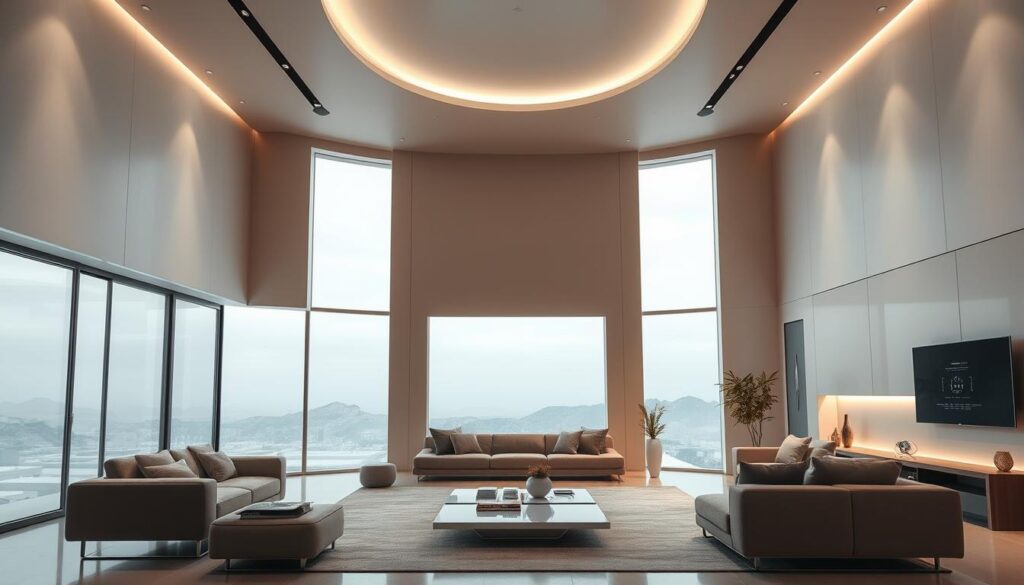
In conclusion, making our smart homes work well requires careful planning. By hiding wires and choosing simple designs, we can have a home that’s both high-tech and stylish.
Creating a Unified Smart System
To make your home truly connected, you need a unified smart system. This means linking different smart devices and technologies together. They should work as one unit, easy to control and manage.
Centralized Control Options
Having a single way to control all devices is key. You can use smart home hubs or voice-controlled assistants like Amazon Alexa or Google Assistant for this.
- Smart home hubs connect many devices, making control easy.
- Voice-controlled assistants make managing your smart home simple.
Importance of Connectivity
How well your smart devices connect is very important. Fast and reliable internet lets them talk to each other smoothly. This gives you a better experience.
| Connectivity Type | Speed | Reliability |
|---|---|---|
| Wi-Fi | High | Medium |
| Ethernet | Very High | High |
| Bluetooth | Medium | Medium |
When setting up your smart home, think about your connectivity options. Choose the best ones for your needs. A unified smart system is more than just smart devices. It’s about a well-integrated and functional home.
Smart Home Interior Design Trends
The future of smart home design is here, blending tech with style. It’s important to keep up with the latest trends. These trends make our homes convenient, stylish, and eco-friendly.
Eco-Friendly Solutions
Eco-friendly solutions are a big trend in smart home design. People want to reduce their environmental impact without losing style or function. They use sustainable materials, energy-saving appliances, and smart lights that adjust to natural light.
Eco-friendly smart home devices are getting popular. They help manage energy and water use. For example, smart thermostats learn your habits to save energy.
Multi-functional Spaces
Modern design focuses on multi-functional spaces. With more people working from home, homes need to be versatile. This means spaces that can change from work to play to rest.
Smart furniture and modular designs help create these spaces. A smart coffee table can charge devices, and a wall desk folds up when not needed. This saves space and makes rooms more flexible.
By adopting these trends, your home can be both high-tech and adaptable. It meets your changing needs in style.
Challenges in Smart Home Design
Smart home interior design is exciting but comes with challenges. It needs careful planning and thought about many factors.
Smart home design is more than just adding tech. It’s about making our homes better without feeling too much.
Overwhelming Options
The smart home market has many devices and systems. This makes it hard for homeowners to pick what’s best. There are smart lighting solutions and voice-controlled assistants, among others.
To not feel overwhelmed, it’s key to know what you need. Choose devices that really make a difference in your life.
- Start by assessing your current lifestyle and habits.
- Determine which aspects of your home you want to automate or enhance.
- Research different devices and systems to find the ones that best fit your needs.
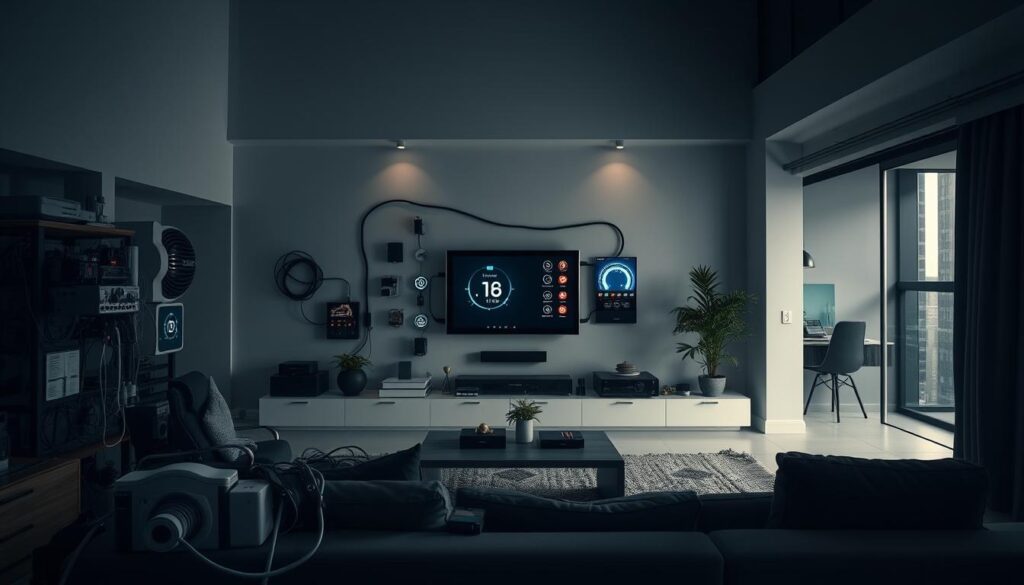
Technical Issues
Technical problems are a big challenge in smart home design. Issues like connectivity problems and device malfunctions can mess up your system.
To avoid these problems, choose devices from trusted brands. Make sure they work well with your current setup. Regular updates and maintenance can also help.
By knowing these challenges and taking steps to solve them, we can make a smart home that’s both new and useful.
DIY Smart Home Interior Design
DIY smart home interior design is a fun way to add tech to your home. With a few easy projects, you can turn your home into a smart, comfy, and stylish space.
Simple Projects to Start With
Start with simple DIY smart home projects. They can make a big difference. Here are some ideas:
- Install smart lights that you can control from anywhere or set to change with the day.
- Get a smart thermostat that learns your temperature likes and adjusts itself.
- Use voice assistants to control your smart devices and get info.
These projects are perfect for beginners. They’re easy to do and offer quick benefits like saving energy and being more convenient.
Using Apps for Design
There are also many apps to help with smart home design. These apps can help with planning and managing your smart devices.
Some top apps for smart home design let you:
- See what your smart home will look like before buying anything.
- Control your devices from anywhere, so you can adjust settings even when you’re out.
- Keep an eye on how much energy you’re using and find ways to save.
Using these apps can make your smart home more efficient and tailored to your needs. It can also improve your living experience.
When starting your DIY smart home project, think about things like compatibility, budget, and what you need. With good planning and the right tools, you can make a technology-infused home design that’s both useful and looks great.
Hiring a Professional for Smart Home Design
Choosing to hire a professional for your smart home can make a big difference. Smart home tech is getting more complex. A pro can make sure your home works well and looks great.
When to Consider an Expert
You might not always need a pro for smart home design. But, if you’re doing a big renovation or building a new home, it’s a good idea. A pro can make sure smart tech fits well with your design, using modern smart home aesthetics and futuristic interior design concepts.
Finding a Qualified Designer
To find a good designer, start by looking for experts in your area. Check their portfolios and read what past clients say. Also, ask friends or family for recommendations. Knowing what what is smart home interior design and how it can fit your style is key.
Here’s a look at the pros and cons of hiring a pro versus doing it yourself for smart home design:
| Aspect | Hiring a Professional | DIY Approach |
|---|---|---|
| Cost | Higher upfront cost | Lower initial cost, but potential for costly mistakes |
| Expertise | Access to specialized knowledge and experience | Limited by your own knowledge and time |
| Time Commitment | Less time-consuming for you | Significant time investment |
Future of Smart Home Interior Design
Smart home interior design is set to play a bigger role in our homes. Trends like sustainable tech, health monitoring, and AI are changing the game. They will shape the future of our living spaces.
Emerging Trends
There’s a big move towards smart home decor trends that focus on being green. We’re seeing designs that blend tech with nature. This includes gadgets that save energy and materials that change with the environment.
Technological Advancements
Making our homes tech-friendly is getting easier. Thanks to voice assistants and smart systems, our homes can do more for us. We’ll see even more cool tech that makes life simpler.
Keeping up with smart home trends helps us build homes that are smart and stylish. Our homes will be more than just places to live; they’ll be intelligent and responsive to our needs.

